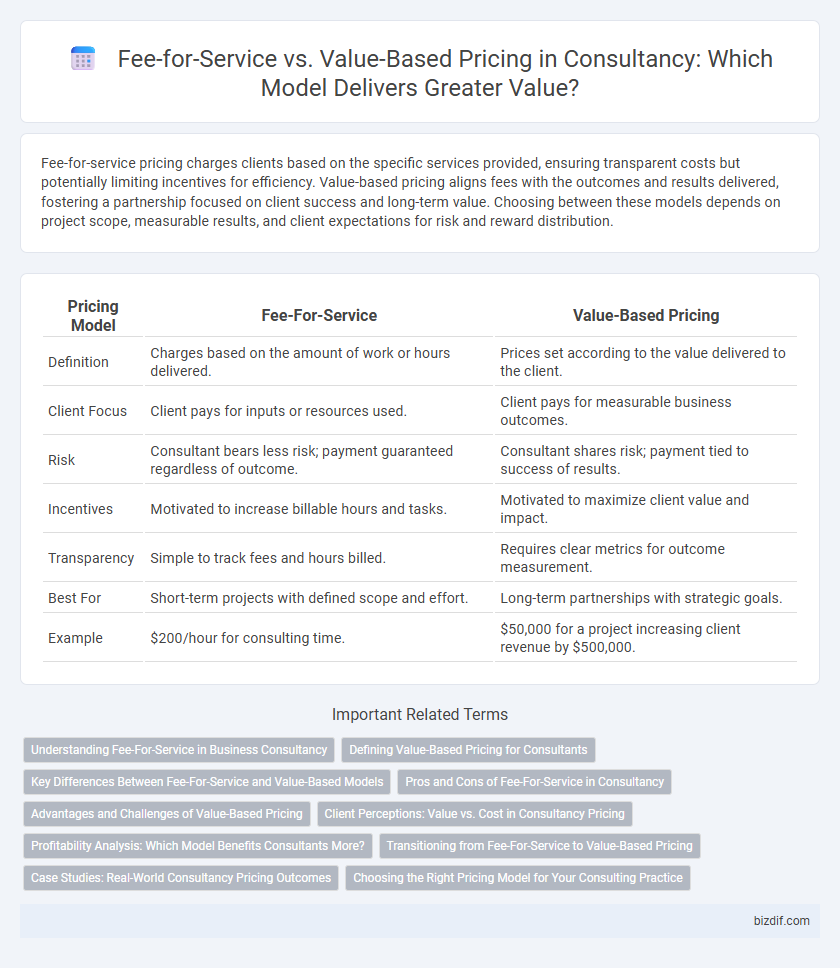Fee-for-service pricing charges clients based on the specific services provided, ensuring transparent costs but potentially limiting incentives for efficiency. Value-based pricing aligns fees with the outcomes and results delivered, fostering a partnership focused on client success and long-term value. Choosing between these models depends on project scope, measurable results, and client expectations for risk and reward distribution.
Table of Comparison
| Pricing Model | Fee-For-Service | Value-Based Pricing |
|---|---|---|
| Definition | Charges based on the amount of work or hours delivered. | Prices set according to the value delivered to the client. |
| Client Focus | Client pays for inputs or resources used. | Client pays for measurable business outcomes. |
| Risk | Consultant bears less risk; payment guaranteed regardless of outcome. | Consultant shares risk; payment tied to success of results. |
| Incentives | Motivated to increase billable hours and tasks. | Motivated to maximize client value and impact. |
| Transparency | Simple to track fees and hours billed. | Requires clear metrics for outcome measurement. |
| Best For | Short-term projects with defined scope and effort. | Long-term partnerships with strategic goals. |
| Example | $200/hour for consulting time. | $50,000 for a project increasing client revenue by $500,000. |
Understanding Fee-For-Service in Business Consultancy
Fee-For-Service in business consultancy involves charging clients based on the specific services rendered, such as hourly rates or project fees, providing transparent and straightforward billing. This pricing model allows consultants to monetize their time and expertise directly, facilitating predictable revenue streams and clear deliverables. Understanding the nuances of Fee-For-Service helps businesses evaluate cost efficiency and align consultant efforts with measurable outputs.
Defining Value-Based Pricing for Consultants
Value-based pricing for consultants is a strategy where fees are determined by the measurable value delivered to the client rather than the hours worked or fixed costs. This model aligns consultant compensation with client outcomes, enhancing incentives for delivering impactful, results-driven solutions. By basing charges on business impact metrics such as increased revenue, cost savings, or efficiency improvements, consultants can better demonstrate the ROI of their services.
Key Differences Between Fee-For-Service and Value-Based Models
Fee-For-Service pricing in consultancy charges clients based on the number of hours worked or specific tasks completed, linking revenue directly to effort and time invested. Value-Based Pricing, however, sets fees according to the measurable business outcomes or value delivered to the client, emphasizing results rather than inputs. The key difference lies in Fee-For-Service focusing on activity quantification, while Value-Based Pricing prioritizes client impact and return on investment.
Pros and Cons of Fee-For-Service in Consultancy
Fee-for-service pricing in consultancy offers clear advantages such as straightforward billing based on hours worked, making costs predictable for clients and simpler to track for consultants. However, this model may encourage inefficiency since revenue depends on time spent rather than delivered value, potentially leading to client dissatisfaction if outcomes do not meet expectations. Additionally, fee-for-service can restrict innovation and collaboration because consultants might focus on billable hours instead of optimizing overall project impact.
Advantages and Challenges of Value-Based Pricing
Value-based pricing in consultancy aligns fees with the measurable impact delivered, enhancing client satisfaction and long-term partnerships through outcome-focused engagements. This model motivates consultants to prioritize high-value solutions and innovation, often leading to premium pricing opportunities and competitive differentiation. Challenges include accurately quantifying value, managing client expectations, and the complexity of structuring agreements that fairly reflect risk and reward for both parties.
Client Perceptions: Value vs. Cost in Consultancy Pricing
Clients often perceive fee-for-service pricing as transparent but may view it as costly when project scope expands unexpectedly. Value-based pricing aligns payment with tangible outcomes, enhancing client satisfaction by directly linking fees to delivered value. This approach fosters trust and long-term partnerships, as clients prioritize measurable benefits over time-based costs.
Profitability Analysis: Which Model Benefits Consultants More?
Fee-for-service pricing guarantees predictable revenue by charging clients for each individual task or hour, enabling straightforward profit margin calculations but often limiting upside potential. Value-based pricing aligns fees with the measurable business outcomes delivered, incentivizing consultants to optimize performance and capture higher profits through enhanced client value. Profitability analysis reveals that consultants adopting value-based models typically achieve superior long-term margins, driven by scalable impact and stronger client retention.
Transitioning from Fee-For-Service to Value-Based Pricing
Transitioning from fee-for-service to value-based pricing requires a strategic shift to align consultancy fees with client outcomes and measurable value delivered. This approach incentivizes performance improvements and fosters long-term partnerships by emphasizing results over hours billed. Successful transition hinges on clear client communication, robust metrics development, and adaptable contract structures to reflect evolving project impacts.
Case Studies: Real-World Consultancy Pricing Outcomes
Case studies in consultancy reveal that Fee-For-Service models often simplify revenue forecasting but may limit profitability during high-impact projects, while Value-Based Pricing aligns fees with client outcomes, driving higher client satisfaction and increased long-term revenue. Firms employing Value-Based Pricing report up to 30% higher margins by capturing the economic value delivered, as illustrated by successful engagements in digital transformation and strategy consulting. Analysis of consulting firms leveraging these models shows that Value-Based Pricing fosters stronger client relationships and repeat business compared to traditional hourly or project-based Fee-For-Service arrangements.
Choosing the Right Pricing Model for Your Consulting Practice
Selecting the right pricing model for your consulting practice hinges on understanding the benefits of Fee-For-Service, which offers predictability through fixed rates per deliverable, and Value-Based Pricing, which aligns fees with the measurable impact and outcomes delivered to clients. Consultants who implement Value-Based Pricing can enhance profitability by directly linking compensation to client ROI, fostering stronger client relationships and incentivizing high performance. Analyzing client needs, project scope, and industry standards is essential to determine whether a transparent Fee-For-Service or a flexible Value-Based Pricing model maximizes both client satisfaction and business growth.
Fee-For-Service vs Value-Based Pricing Infographic

 bizdif.com
bizdif.com